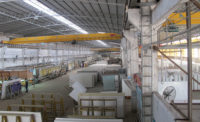By now, most are aware of the silicosis “epidemic” (herein meaning both health-wise and industry-affect-wise) rapidly unfolding worldwide having some profound ramifications. I believe for all stakeholder’s sake, it is absolutely critical to understand the condition more acutely and to answer this, we need to peel back a layer or two at the chemo-geologic beginning. I’d like to note, this material can get quite deep into geology and chemistry, far beyond my expertise. However, I will strive to bring the major concepts to a “lay” level hoping to increase understanding and awareness.
Engineered stone has historically contained north of around 90% quartz rock; a mineral with the chemical symbol of SiO2 (silicon dioxide), as a raw material. I have been told there is a sort of pragmatic upper limit of around 93% and yet, as the category has matured and “recipes” changed over the years, some formulations of engineered stone’s actual quartz content has slid down to the low 80s as a percent and actually, even lower in some instances. As of 2024, the number of different “recipes” to make engineered stone are vast whose motivations ranging from lowering costs to circumventing tariffs to more recently, intentional reformulation to lower the amount of crystalline silica content within the slab.
While there are many products that contain crystalline silica, engineered stone is getting the most attention now due to its incredible proliferation over the past 20 years coupled with its relatively high percentage of silica within the slab product. That said, the table below shows some common natural materials with their relative average silica content (%); all of which need to be put under the silicosis hazard umbrella.
Noteworthy here is quartzite. Due to its stunning array of colors and exotic patterns, relative rarity and the fact that it can look like a very elegant/expensive marble yet not have many of the same worries and maintenance issues as a soft marble, quartzite has become a trending favorite with designers and stone specifiers. This natural stone is essentially a large chunk of natural quartz – consisting of 90 to 99% SiO2. Ironically, on average, quartzite appears to have more silicon dioxide in it than the average slab of engineered stone.
The relative sales of quartzite versus engineered stone are much smaller and hence, not really being singled out at this time. However, as you will find out later in this article, much as I predicted a silicosis epidemic back in 2016, I will say now, that quartzite contains as much if not more silica, and as the popularity of this material continues to grow, it must not be ignored and must be dealt with, in-kind to engineered stone and other high silica content materials.
Quartz and SiO2:
The Yin & Yang Genesis
Quartz, aka, silica, is the second most abundant mineral found in the crust of planet earth. Myriad building materials such as gravel, concrete, stone and sand contain silica and not surprisingly then, it is also used to make countless products such as glass, pottery, bricks and ceramics. The vast majority of solids on earth, including silica, have a crystalline atomic structure (versus an amorphous structure) and it is this fundamental attribute of silica that creates the hazard for pulmonary fibrosis (silicosis).
Left “undisturbed” and in its material, silica is not harmful. However, (and here is the BIG however…) the dry acts such as, grinding, polishing, cutting, drilling and crushing can release very fine dust particles, (many times smaller than a grain of sand). When airborne, these dust particles, mostly 10 micrometers in size and smaller, are too small to see, but can be inhaled deep into the lungs where they can cause damage. The smaller the crystalline silica particles, the greater the risk of respiration and disease.
Despite their miniscule size, these silica dust particles have very sharp “edges,” and yes, as a direct result of the crystalline atomic structure. Therefore, when breathed in, these sharply edged particles go deep into the lungs where they invariably damage lung tissues; all of which then kicks in our body’s immune response causing swelling and permanent scarring around these micro-abrasions effectively rendering the lungs to no longer function properly. (see Figure 1)
The amount of damage to the lungs is a function of both how long one has been exposed to respirable silica and in what concentration the dust stays in some volume of space. The effect of silicosis resides on a spectrum as you would imagine and yet, regardless of where on that spectrum one’s affect resides, as we know today, silicosis has no cure because the lung damage cannot be reversed.
Treatment efforts are designed per case hoping to make the individual more comfortable by relieving some of the symptoms. With respect to reducing lung mucus, inhaled steroids can be prescribed while for others with more constricted breathing passages, bronchodilators can be tried. In the most extreme cases, while lung transplants might theoretically be an option, the truth is, the number of severe cases of silicosis and other lung diseases, (far! far!) exceeds the number of donated lungs available.
What makes silicosis so challenging, is that, on average, chronic silicosis typically occurs over a very long span of time. One can typically expect symptoms to appear somewhere between 10 and 20 years of exposure to respirable silica. Sadly, there are exceptions. As I previously mentioned, that affect is a function of both concentration and duration. There are examples where both conditions were excessive and therefore measurable and physical affect could start in less than one year.
Left undiagnosed, one could start experiencing symptoms such as chest pain, persistent coughing, weakness and fatigue, and shortness of breath. These symptoms would likely be exaggerated during exercise and exertion, and in some cases could be the initial indication of malady. As the disease progresses, one may experience extreme pain, coughing and shortness of breath, and potentially, respiratory failure. Furthermore, exposure to respirable crystalline silica increases the risk of lung cancer, kidney disease and COPD.
Since affect is typically below one’s awareness, workers need to be supremely diligent in following safety protocols (we will address later) and remain proactive about screenings and regular check-ups. Chest x-rays can help determine if there is any lung damage. While early detection of some level of silicosis does not help in reversing or curing, it is extremely important to identify so an immediate analysis of work conditions can be evaluated so as to prevent any incremental exposure which can have a compounded negative effect.
Historically, the most at risk to develop these diseases are miners, construction workers, and oil and gas engineers that are often performing the tasks or processes that release the dangerous respirable crystalline silica dust. However, since the domestic introduction of engineered stone some 25+ years ago, it is largely within the conversion process, i.e., fabrication and installation, that has greatly increased the hazards and sadly, incidents’ rates in the countertop fabrication industry.
Let’s look closer at the timeline to see why now do the number of reported cases seem to be increasing steadily. (all dates following are approximate)
Late 1990’s engineered stone is widely introduced across the U.S. as a new category of surfacing – predominantly piloted by two large international surfacing companies.
Category acceptance started slow but within a few years gained significant momentum and the offering began to take market share most noticeably from solid surface and natural stone due to its price/value proposition.
2006 Consumer Reports published one of their evaluations on countertop options. This was the first-time engineered stone topped the charts as the #1 overall-rated countertop choice. (Aesthetics, durability, no sealing, feel, price, warranty and hygiene were all considered together as the overall value proposition.)
Circa 2010, engineered stone is enjoying significant steady and projected growth. Imports began to rise sharply seeing the vast business opportunity here. By this time, the technology to make engineered stone had been reverse engineered and low-cost product began to flood the market largely from Asia.
This was enabled largely due to the fact that foreign entities would sell containers to most anyone whose check cleared. There was no shop sophistication, capacity or technology vetting of the buyer; no worry about channel conflicts since these were direct purchases and to my knowledge, none of these entities brought any awareness to the potential of silicosis.
2020: Despite the COVID-19 pandemic and ensuing economic recession, engineered stone still enjoyed growth and maintained positive projected future growth.
While one major brand proactively and aggressively addressed the risks associated with micro-crystalline respiration from the very onset of their brand’s introduction in the late 90s, it did appear to take some years before most other rooted and growing brands adopted some sort of awareness policies.
Bringing all of this full circle, with an average 10- to 20-year gestation period for silicosis, it is now clear why this epidemic is only recently rearing its ugly head with respect to the fabrication industry.
It was 2016 when I wrote an article in Countertops & Architectural Surfaces magazine discussing industry “happenings” and formally suggested to the fabrication industry that there was a powerful and devastating tsunami heading our way. As unsettling and foreboding as this metaphor was, it seemed to perfectly describe the latency of silicosis in our industry. Understanding quite well how the industry had been unfolding for the past 10 years at that point, really triggered great concern inside me of a serious health crisis looming. So much so, I began using the phrase, “it’s not if, it’s when.”
Quartz Industry Re-Defining
Current Events:
In a release by Reuters on February 7, 2023(1), the owner of a highly recognizable and successful global brand of quartz from Spain “accepted a six-month suspended prison sentence for five counts of serious injury due to gross negligence in a plea bargain with the court.”
In December 2023(2), Stone-Update published this landmark announcement: The country’s (Australia) workplace-safety officials voted unanimously on December 13th to “prohibit the use supply and manufacture of all engineered stone, with the majority of jurisdictions to commence the prohibition from July 1, 2024.” The release goes on to mention, “The officials also noted that the country intends to bar imports of engineered stone to provide an additional layer of enforcement and deterrence at the border.”
December 14, 2023(3), the State of California Department of Industrial Relations had a release which included this: “Sacramento — The Occupational Safety and Health Standards Board today approved an emergency temporary standard on respirable crystalline silica to protect workers from silicosis. The standard will go into effect on December 29, 2023…Cal/OSHA proposed the emergency temporary standard to protect workers in the stone fabrication industry from silicosis... The California Department of Public Health has identified 95 cases of workers developing silicosis since 2019, 10 of whom have died from the disease.”
February 2024, CBS Mornings aired a very moving video of a fabricator suffering with silicosis under the caption: “The production of crushed quartz countertops may be causing deadly lung issues in workers.”
Silicosis is a slow and stealthy danger whose earliest documentation dates back to around 1700 by Dr. Bernardino Ramazzini. Many more cases in a wider array of industries have been documented throughout the 1900s, creating awareness programs and emphasis campaigns. In 1996, OSHA drafted a comprehensive silica standard for the construction industry and while it took many years to go through the lawmaking process, 2016 did see a “Final Rule”(4) issued to protect workers from exposure to respirable crystalline silica.
It is safe to say that the engineered stone landscape is changing before our eyes. While much remains to be seen what this will eventually look like, it is a rather ubiquitous consensus that reform is needed to ensure proper education and awareness, safe and appropriate work environments and accountability.
In Part 2 of this series due to publish May 2024, we will delve into industry voices, non-crystalline silica raw material alternatives, crystalline silica reduction strategies, tooling options to address control, filtering and overall mitigation, and take a closer look into what OSHA says about the disease and some of the tools they and our industry are providing for education. This is a very current and fluid topic, be sure to check back in with us in May to stay on the leading edge.
Paul Max Le Pera has 20+ years in Building Materials Executive Leadership who remains deeply active in product launches, brand management and global business development.
He also serves as vice president and board member of the International Surface Fabricators Association (ISFA) as well as National Expert on the U.S. technical advisory group to ISO's team creating Global Standards for quartz surfacing.








